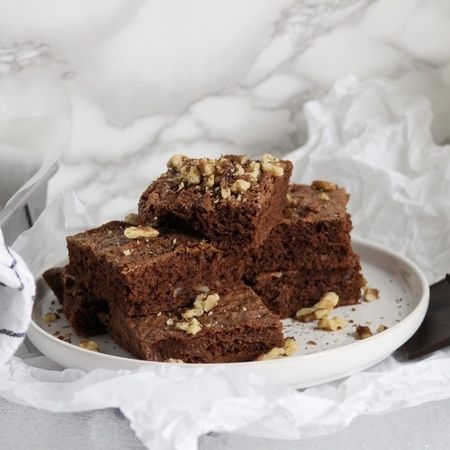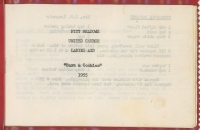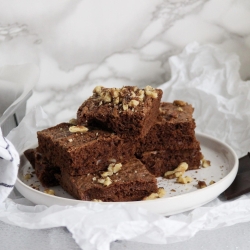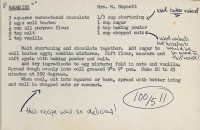
 604 465 4322
604 465 4322General Store Site 12294 Harris Road Pitt Meadows, B.C.
Click Here for Directions& Visiting Hours

Brownies 1955
Recipe
*****
Sweet, chocolatey, ooey-gooey brownies are a dessert we have all had the pleasure of indulging in, but their creation is as much a mystery as is the reason this dessert got its name. Shrouded in many tales of folklore, the actual history of the brownie recipe to this day is still unknown. Some stories spin a yarn about a chef accidentally adding melted chocolate to a batch of cookies or another tale of someone making a cake but running out of flour before finishing the dessert. But the most famous legend is a housewife making a chocolate cake but forgetting to add baking powder. So when the cake didn’t rise properly, she cut it into small squares and served it to her guests instead of throwing it out. As for the name brownies, could there be a connection between the decadent dessert and a small goblin that loves to clean your house? According to Celtic folklore, Brownies are hairy goblin creatures that show up at night to complete chores around the house. It is custom to make offerings to them as it is believed it brings prosperity. Offerings include bowls of fresh cream, oatmeal or perhaps even a plate of freshly baked chocolate brownies. But be careful what the offering consists of because they offend easily and might disappear before they finish cleaning your house. Unfortunately, no records connect the addictive dessert to the housekeeping goblins. Although the name remains a question, the mystery behind these tales continues to be a real page-turner.
After the overwhelming events of the previous decade, the 1950s in Canada sought its own eagerness towards change and progress. Following WWII, the economy boomed, especially with manufacturing industries and a deep investment in infrastructure, which led to the construction of the Trans-Canada Highway, connecting the country from coast to coast. The country also saw a significant increase in the birth rate, commonly known as the “baby boom,” which led to a completely different shift in demographic. Although WWII was behind us, there were still tensions between the Western powers. Since Canada was a close ally of the United States, it led to the formation of NATO in 1949, which served as a defensive alliance against Soviet aggression. Social conservatism was also expressed in the 1950s, with the traditional nuclear family image at the forefront of the country’s ideals. This view expressed family values and dedicated gender roles with a male father earning and supporting the entire family, a dutiful wife and mother taking care of the home and children, and two kids in the yard, looking at their family dynamic as future inspiration. There was pressure to fit this stereotypical mould because it symbolized stability and social order. Despite the conservative values, Canada had an emergence of new cultural trends such as Rock and Roll, leather jackets, promotion of material possession and consumerism, television, and national identity. Canada was hungry for change and would continue its devotion toward a prosperous nation.
The 1950s also marked a turning point for Pitt Meadows. After the 1948 flood, repairs were attempted in the Pitt Polder area but were unsuccessful due to continuous flooding. It wasn’t until Dr. Jan Blom arrived in the area in 1950 and purchased the land which would become Pitt Polder Ltd. The reclamation work quickly began, restoring the area into viable agricultural land. At this point in time, the population in Pitt Meadows was slowly rising, reaching about 1,600 residents by 1955. New schools were also emerging, with Pitt Meadows Elementary first in 1953 and Edith McDermott as its first principal. Then came Meadowland Elementary and Pitt Meadows Secondary school eight years later. With an increase in traffic, the original 1915 bridge over the Pitt River was replaced in 1957, with Douglas McMyn ceremoniously crossing the bridge first, just like he had back in 1915. He would also be the first to cross the new bridge built in the 1970s. This decade also brought a new volunteer fire department, with Dick Koopman as the first Chief, and the first fire hall built on Harris Road. Unfortunately, this building no longer exists. Pitt Meadows also saw its first service club, with the Pitt Meadows Lions forming in 1951 and building the Lions Den in 1957-1958 using old timbers from the Number One School House. The Lions Park Playground now occupies the site of the schoolhouse, with the Lions Den still standing on Harris Road. The decade also brought blueberry farming to Pitt Meadows, with the community’s first farm, Blue Boy Blueberry Co, Ltd, planted in 1952. All these changes within Pitt Meadows emphasized leaving the past, especially after WWII, and continuing to progress as a community.
Although the little goblins hold no ties to the brownie dessert, the curious mystery surrounding the creation of the original recipe still stands. What we know with certainty is that the recipe shared by Mrs. M. Hopcott is absolutely delicious. A simple, quick dessert was achieved by not worrying about rationing but instead indulging in decadent ingredients. Perhaps this is what this recipe is meant to symbolize, the cultural shift post-war seeming like an enigma itself. Craving changes not only with our clothes, possessions, music, or food but a social change deviating from the old way of thinking or wanting. Life after the war seemed renewed, and refreshed, almost as if the curtain finally lifted and revealed a bright and prosperous future, and people were left wanting more.

Ladies Aid Cookbook 1955

1955 Brownies

Recipe from the Ladies Aid Cookbook for brownies 1955





